Conceptual Framework & IAS 17: Financial Reporting Analysis Report
VerifiedAdded on 2023/03/20
|13
|4307
|24
Report
AI Summary
This report delves into the intricacies of financial reporting, beginning with an exploration of the conceptual framework, its objectives, and qualitative characteristics. It defines and classifies assets and liabilities, explaining their recognition and disclosure in financial statements, along with their advantages and disadvantages. The report then provides a comprehensive overview of lease accounting under IAS 17, including lease definitions, types, and classification methods. It discusses the recognition and disclosure of leases, calculation methods, and their advantages and disadvantages. The report covers the historical context and development of accounting standards, particularly focusing on the role of IAS 17 and its impact on financial reporting practices. The analysis incorporates relevant accounting standards, practical examples, and regulatory discussions to provide a thorough understanding of the subject matter.
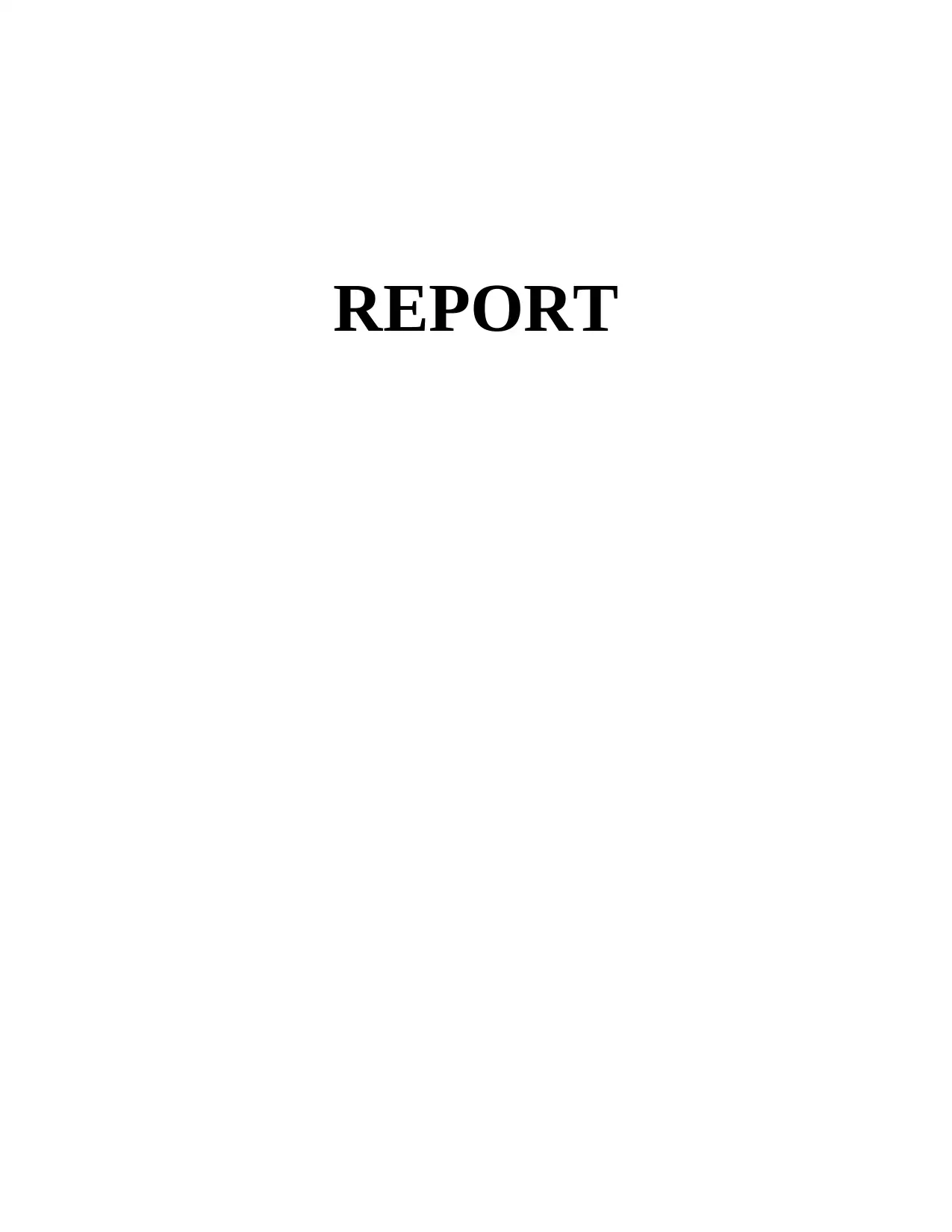
REPORT
Paraphrase This Document
Need a fresh take? Get an instant paraphrase of this document with our AI Paraphraser
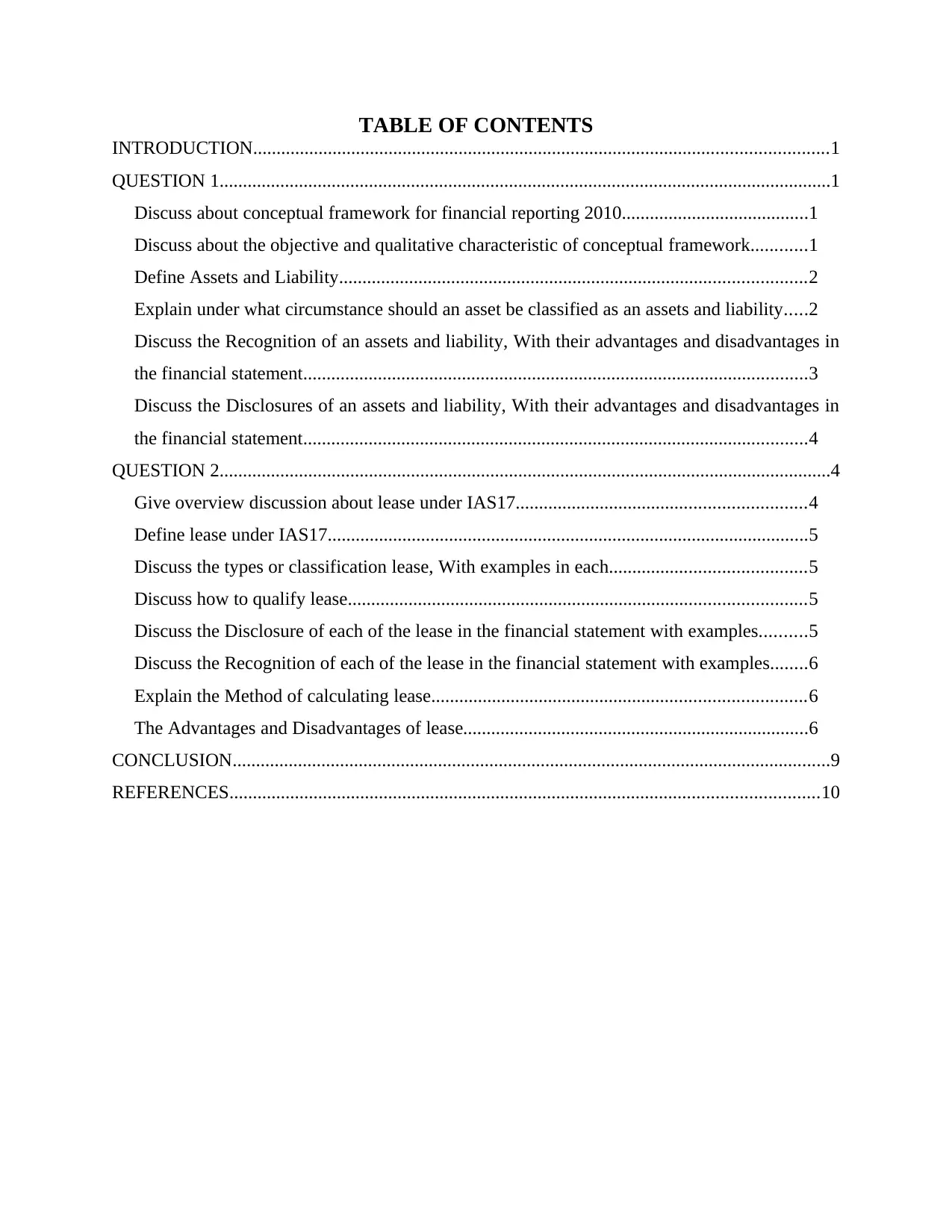
TABLE OF CONTENTS
INTRODUCTION...........................................................................................................................1
QUESTION 1...................................................................................................................................1
Discuss about conceptual framework for financial reporting 2010........................................1
Discuss about the objective and qualitative characteristic of conceptual framework............1
Define Assets and Liability....................................................................................................2
Explain under what circumstance should an asset be classified as an assets and liability.....2
Discuss the Recognition of an assets and liability, With their advantages and disadvantages in
the financial statement............................................................................................................3
Discuss the Disclosures of an assets and liability, With their advantages and disadvantages in
the financial statement............................................................................................................4
QUESTION 2...................................................................................................................................4
Give overview discussion about lease under IAS17..............................................................4
Define lease under IAS17.......................................................................................................5
Discuss the types or classification lease, With examples in each..........................................5
Discuss how to qualify lease..................................................................................................5
Discuss the Disclosure of each of the lease in the financial statement with examples..........5
Discuss the Recognition of each of the lease in the financial statement with examples........6
Explain the Method of calculating lease................................................................................6
The Advantages and Disadvantages of lease..........................................................................6
CONCLUSION................................................................................................................................9
REFERENCES..............................................................................................................................10
INTRODUCTION...........................................................................................................................1
QUESTION 1...................................................................................................................................1
Discuss about conceptual framework for financial reporting 2010........................................1
Discuss about the objective and qualitative characteristic of conceptual framework............1
Define Assets and Liability....................................................................................................2
Explain under what circumstance should an asset be classified as an assets and liability.....2
Discuss the Recognition of an assets and liability, With their advantages and disadvantages in
the financial statement............................................................................................................3
Discuss the Disclosures of an assets and liability, With their advantages and disadvantages in
the financial statement............................................................................................................4
QUESTION 2...................................................................................................................................4
Give overview discussion about lease under IAS17..............................................................4
Define lease under IAS17.......................................................................................................5
Discuss the types or classification lease, With examples in each..........................................5
Discuss how to qualify lease..................................................................................................5
Discuss the Disclosure of each of the lease in the financial statement with examples..........5
Discuss the Recognition of each of the lease in the financial statement with examples........6
Explain the Method of calculating lease................................................................................6
The Advantages and Disadvantages of lease..........................................................................6
CONCLUSION................................................................................................................................9
REFERENCES..............................................................................................................................10
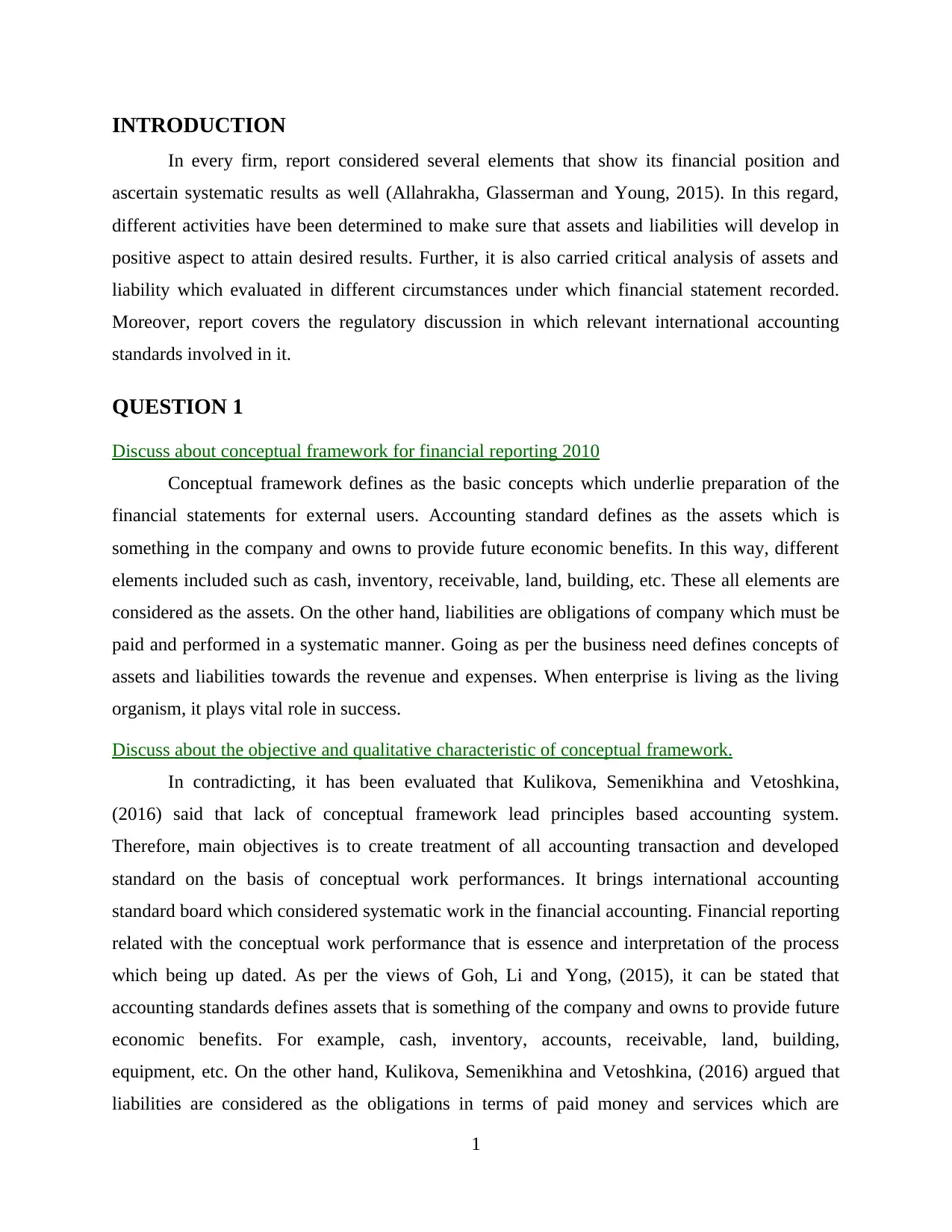
INTRODUCTION
In every firm, report considered several elements that show its financial position and
ascertain systematic results as well (Allahrakha, Glasserman and Young, 2015). In this regard,
different activities have been determined to make sure that assets and liabilities will develop in
positive aspect to attain desired results. Further, it is also carried critical analysis of assets and
liability which evaluated in different circumstances under which financial statement recorded.
Moreover, report covers the regulatory discussion in which relevant international accounting
standards involved in it.
QUESTION 1
Discuss about conceptual framework for financial reporting 2010
Conceptual framework defines as the basic concepts which underlie preparation of the
financial statements for external users. Accounting standard defines as the assets which is
something in the company and owns to provide future economic benefits. In this way, different
elements included such as cash, inventory, receivable, land, building, etc. These all elements are
considered as the assets. On the other hand, liabilities are obligations of company which must be
paid and performed in a systematic manner. Going as per the business need defines concepts of
assets and liabilities towards the revenue and expenses. When enterprise is living as the living
organism, it plays vital role in success.
Discuss about the objective and qualitative characteristic of conceptual framework.
In contradicting, it has been evaluated that Kulikova, Semenikhina and Vetoshkina,
(2016) said that lack of conceptual framework lead principles based accounting system.
Therefore, main objectives is to create treatment of all accounting transaction and developed
standard on the basis of conceptual work performances. It brings international accounting
standard board which considered systematic work in the financial accounting. Financial reporting
related with the conceptual work performance that is essence and interpretation of the process
which being up dated. As per the views of Goh, Li and Yong, (2015), it can be stated that
accounting standards defines assets that is something of the company and owns to provide future
economic benefits. For example, cash, inventory, accounts, receivable, land, building,
equipment, etc. On the other hand, Kulikova, Semenikhina and Vetoshkina, (2016) argued that
liabilities are considered as the obligations in terms of paid money and services which are
1
In every firm, report considered several elements that show its financial position and
ascertain systematic results as well (Allahrakha, Glasserman and Young, 2015). In this regard,
different activities have been determined to make sure that assets and liabilities will develop in
positive aspect to attain desired results. Further, it is also carried critical analysis of assets and
liability which evaluated in different circumstances under which financial statement recorded.
Moreover, report covers the regulatory discussion in which relevant international accounting
standards involved in it.
QUESTION 1
Discuss about conceptual framework for financial reporting 2010
Conceptual framework defines as the basic concepts which underlie preparation of the
financial statements for external users. Accounting standard defines as the assets which is
something in the company and owns to provide future economic benefits. In this way, different
elements included such as cash, inventory, receivable, land, building, etc. These all elements are
considered as the assets. On the other hand, liabilities are obligations of company which must be
paid and performed in a systematic manner. Going as per the business need defines concepts of
assets and liabilities towards the revenue and expenses. When enterprise is living as the living
organism, it plays vital role in success.
Discuss about the objective and qualitative characteristic of conceptual framework.
In contradicting, it has been evaluated that Kulikova, Semenikhina and Vetoshkina,
(2016) said that lack of conceptual framework lead principles based accounting system.
Therefore, main objectives is to create treatment of all accounting transaction and developed
standard on the basis of conceptual work performances. It brings international accounting
standard board which considered systematic work in the financial accounting. Financial reporting
related with the conceptual work performance that is essence and interpretation of the process
which being up dated. As per the views of Goh, Li and Yong, (2015), it can be stated that
accounting standards defines assets that is something of the company and owns to provide future
economic benefits. For example, cash, inventory, accounts, receivable, land, building,
equipment, etc. On the other hand, Kulikova, Semenikhina and Vetoshkina, (2016) argued that
liabilities are considered as the obligations in terms of paid money and services which are
1
⊘ This is a preview!⊘
Do you want full access?
Subscribe today to unlock all pages.

Trusted by 1+ million students worldwide
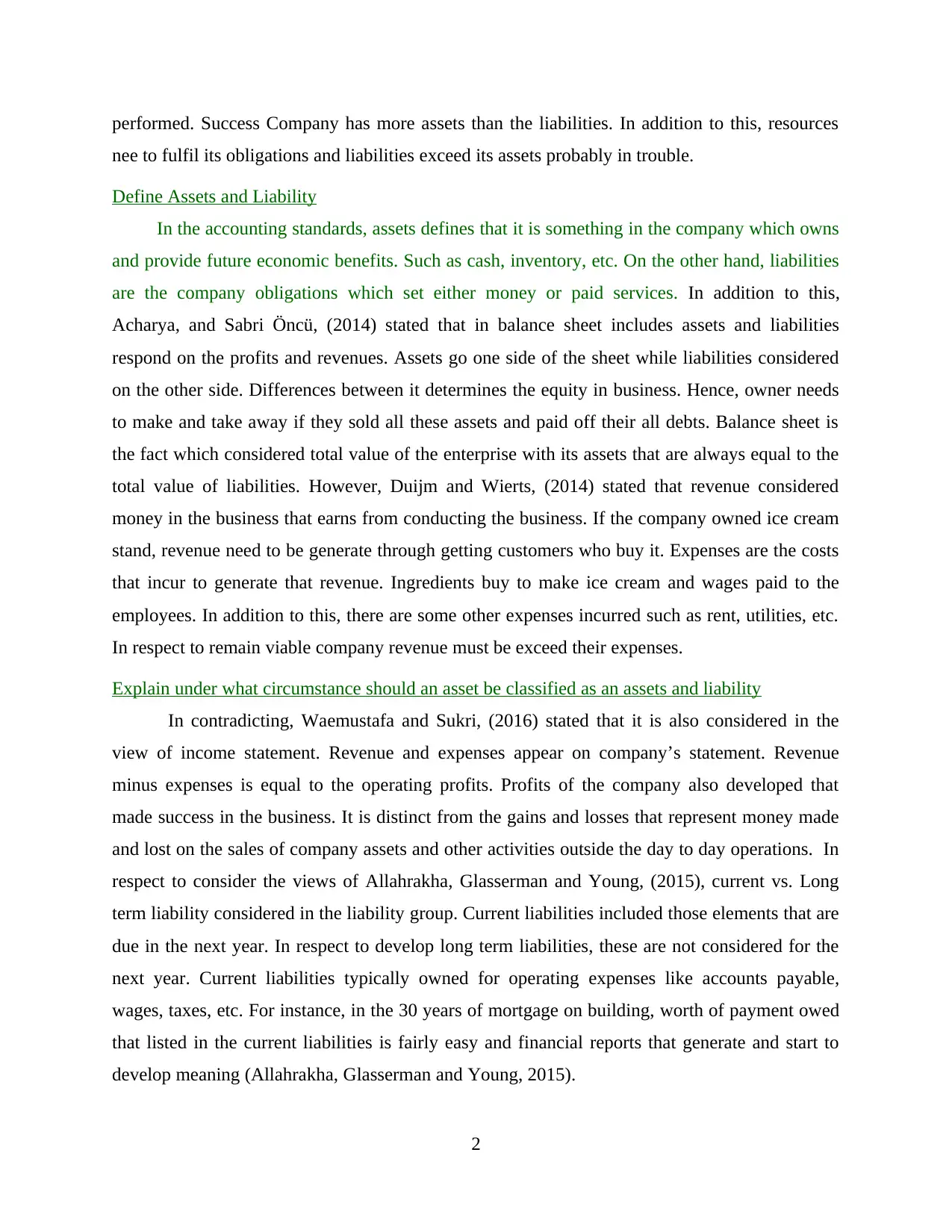
performed. Success Company has more assets than the liabilities. In addition to this, resources
nee to fulfil its obligations and liabilities exceed its assets probably in trouble.
Define Assets and Liability
In the accounting standards, assets defines that it is something in the company which owns
and provide future economic benefits. Such as cash, inventory, etc. On the other hand, liabilities
are the company obligations which set either money or paid services. In addition to this,
Acharya, and Sabri Öncü, (2014) stated that in balance sheet includes assets and liabilities
respond on the profits and revenues. Assets go one side of the sheet while liabilities considered
on the other side. Differences between it determines the equity in business. Hence, owner needs
to make and take away if they sold all these assets and paid off their all debts. Balance sheet is
the fact which considered total value of the enterprise with its assets that are always equal to the
total value of liabilities. However, Duijm and Wierts, (2014) stated that revenue considered
money in the business that earns from conducting the business. If the company owned ice cream
stand, revenue need to be generate through getting customers who buy it. Expenses are the costs
that incur to generate that revenue. Ingredients buy to make ice cream and wages paid to the
employees. In addition to this, there are some other expenses incurred such as rent, utilities, etc.
In respect to remain viable company revenue must be exceed their expenses.
Explain under what circumstance should an asset be classified as an assets and liability
In contradicting, Waemustafa and Sukri, (2016) stated that it is also considered in the
view of income statement. Revenue and expenses appear on company’s statement. Revenue
minus expenses is equal to the operating profits. Profits of the company also developed that
made success in the business. It is distinct from the gains and losses that represent money made
and lost on the sales of company assets and other activities outside the day to day operations. In
respect to consider the views of Allahrakha, Glasserman and Young, (2015), current vs. Long
term liability considered in the liability group. Current liabilities included those elements that are
due in the next year. In respect to develop long term liabilities, these are not considered for the
next year. Current liabilities typically owned for operating expenses like accounts payable,
wages, taxes, etc. For instance, in the 30 years of mortgage on building, worth of payment owed
that listed in the current liabilities is fairly easy and financial reports that generate and start to
develop meaning (Allahrakha, Glasserman and Young, 2015).
2
nee to fulfil its obligations and liabilities exceed its assets probably in trouble.
Define Assets and Liability
In the accounting standards, assets defines that it is something in the company which owns
and provide future economic benefits. Such as cash, inventory, etc. On the other hand, liabilities
are the company obligations which set either money or paid services. In addition to this,
Acharya, and Sabri Öncü, (2014) stated that in balance sheet includes assets and liabilities
respond on the profits and revenues. Assets go one side of the sheet while liabilities considered
on the other side. Differences between it determines the equity in business. Hence, owner needs
to make and take away if they sold all these assets and paid off their all debts. Balance sheet is
the fact which considered total value of the enterprise with its assets that are always equal to the
total value of liabilities. However, Duijm and Wierts, (2014) stated that revenue considered
money in the business that earns from conducting the business. If the company owned ice cream
stand, revenue need to be generate through getting customers who buy it. Expenses are the costs
that incur to generate that revenue. Ingredients buy to make ice cream and wages paid to the
employees. In addition to this, there are some other expenses incurred such as rent, utilities, etc.
In respect to remain viable company revenue must be exceed their expenses.
Explain under what circumstance should an asset be classified as an assets and liability
In contradicting, Waemustafa and Sukri, (2016) stated that it is also considered in the
view of income statement. Revenue and expenses appear on company’s statement. Revenue
minus expenses is equal to the operating profits. Profits of the company also developed that
made success in the business. It is distinct from the gains and losses that represent money made
and lost on the sales of company assets and other activities outside the day to day operations. In
respect to consider the views of Allahrakha, Glasserman and Young, (2015), current vs. Long
term liability considered in the liability group. Current liabilities included those elements that are
due in the next year. In respect to develop long term liabilities, these are not considered for the
next year. Current liabilities typically owned for operating expenses like accounts payable,
wages, taxes, etc. For instance, in the 30 years of mortgage on building, worth of payment owed
that listed in the current liabilities is fairly easy and financial reports that generate and start to
develop meaning (Allahrakha, Glasserman and Young, 2015).
2
Paraphrase This Document
Need a fresh take? Get an instant paraphrase of this document with our AI Paraphraser
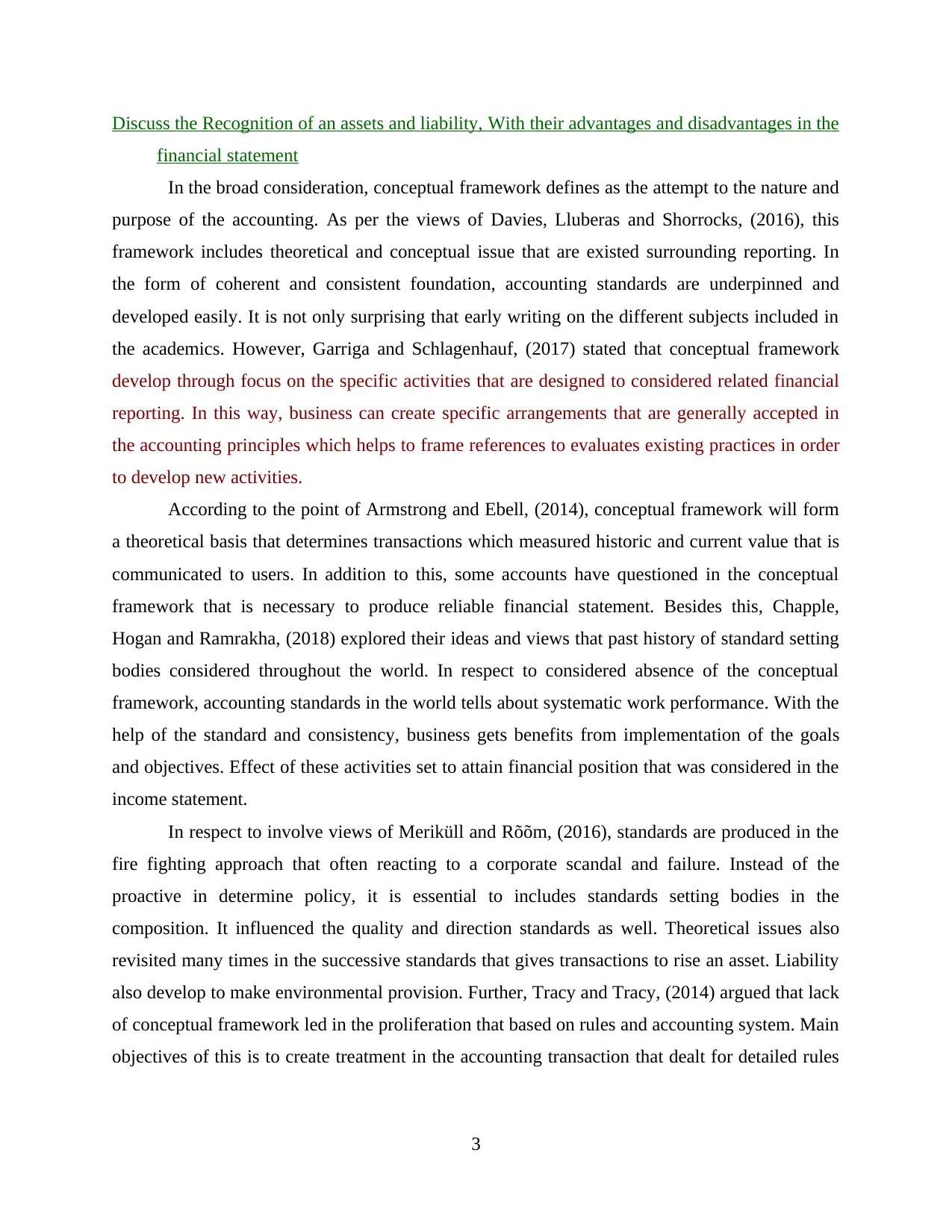
Discuss the Recognition of an assets and liability, With their advantages and disadvantages in the
financial statement
In the broad consideration, conceptual framework defines as the attempt to the nature and
purpose of the accounting. As per the views of Davies, Lluberas and Shorrocks, (2016), this
framework includes theoretical and conceptual issue that are existed surrounding reporting. In
the form of coherent and consistent foundation, accounting standards are underpinned and
developed easily. It is not only surprising that early writing on the different subjects included in
the academics. However, Garriga and Schlagenhauf, (2017) stated that conceptual framework
develop through focus on the specific activities that are designed to considered related financial
reporting. In this way, business can create specific arrangements that are generally accepted in
the accounting principles which helps to frame references to evaluates existing practices in order
to develop new activities.
According to the point of Armstrong and Ebell, (2014), conceptual framework will form
a theoretical basis that determines transactions which measured historic and current value that is
communicated to users. In addition to this, some accounts have questioned in the conceptual
framework that is necessary to produce reliable financial statement. Besides this, Chapple,
Hogan and Ramrakha, (2018) explored their ideas and views that past history of standard setting
bodies considered throughout the world. In respect to considered absence of the conceptual
framework, accounting standards in the world tells about systematic work performance. With the
help of the standard and consistency, business gets benefits from implementation of the goals
and objectives. Effect of these activities set to attain financial position that was considered in the
income statement.
In respect to involve views of Meriküll and Rõõm, (2016), standards are produced in the
fire fighting approach that often reacting to a corporate scandal and failure. Instead of the
proactive in determine policy, it is essential to includes standards setting bodies in the
composition. It influenced the quality and direction standards as well. Theoretical issues also
revisited many times in the successive standards that gives transactions to rise an asset. Liability
also develop to make environmental provision. Further, Tracy and Tracy, (2014) argued that lack
of conceptual framework led in the proliferation that based on rules and accounting system. Main
objectives of this is to create treatment in the accounting transaction that dealt for detailed rules
3
financial statement
In the broad consideration, conceptual framework defines as the attempt to the nature and
purpose of the accounting. As per the views of Davies, Lluberas and Shorrocks, (2016), this
framework includes theoretical and conceptual issue that are existed surrounding reporting. In
the form of coherent and consistent foundation, accounting standards are underpinned and
developed easily. It is not only surprising that early writing on the different subjects included in
the academics. However, Garriga and Schlagenhauf, (2017) stated that conceptual framework
develop through focus on the specific activities that are designed to considered related financial
reporting. In this way, business can create specific arrangements that are generally accepted in
the accounting principles which helps to frame references to evaluates existing practices in order
to develop new activities.
According to the point of Armstrong and Ebell, (2014), conceptual framework will form
a theoretical basis that determines transactions which measured historic and current value that is
communicated to users. In addition to this, some accounts have questioned in the conceptual
framework that is necessary to produce reliable financial statement. Besides this, Chapple,
Hogan and Ramrakha, (2018) explored their ideas and views that past history of standard setting
bodies considered throughout the world. In respect to considered absence of the conceptual
framework, accounting standards in the world tells about systematic work performance. With the
help of the standard and consistency, business gets benefits from implementation of the goals
and objectives. Effect of these activities set to attain financial position that was considered in the
income statement.
In respect to involve views of Meriküll and Rõõm, (2016), standards are produced in the
fire fighting approach that often reacting to a corporate scandal and failure. Instead of the
proactive in determine policy, it is essential to includes standards setting bodies in the
composition. It influenced the quality and direction standards as well. Theoretical issues also
revisited many times in the successive standards that gives transactions to rise an asset. Liability
also develop to make environmental provision. Further, Tracy and Tracy, (2014) argued that lack
of conceptual framework led in the proliferation that based on rules and accounting system. Main
objectives of this is to create treatment in the accounting transaction that dealt for detailed rules
3
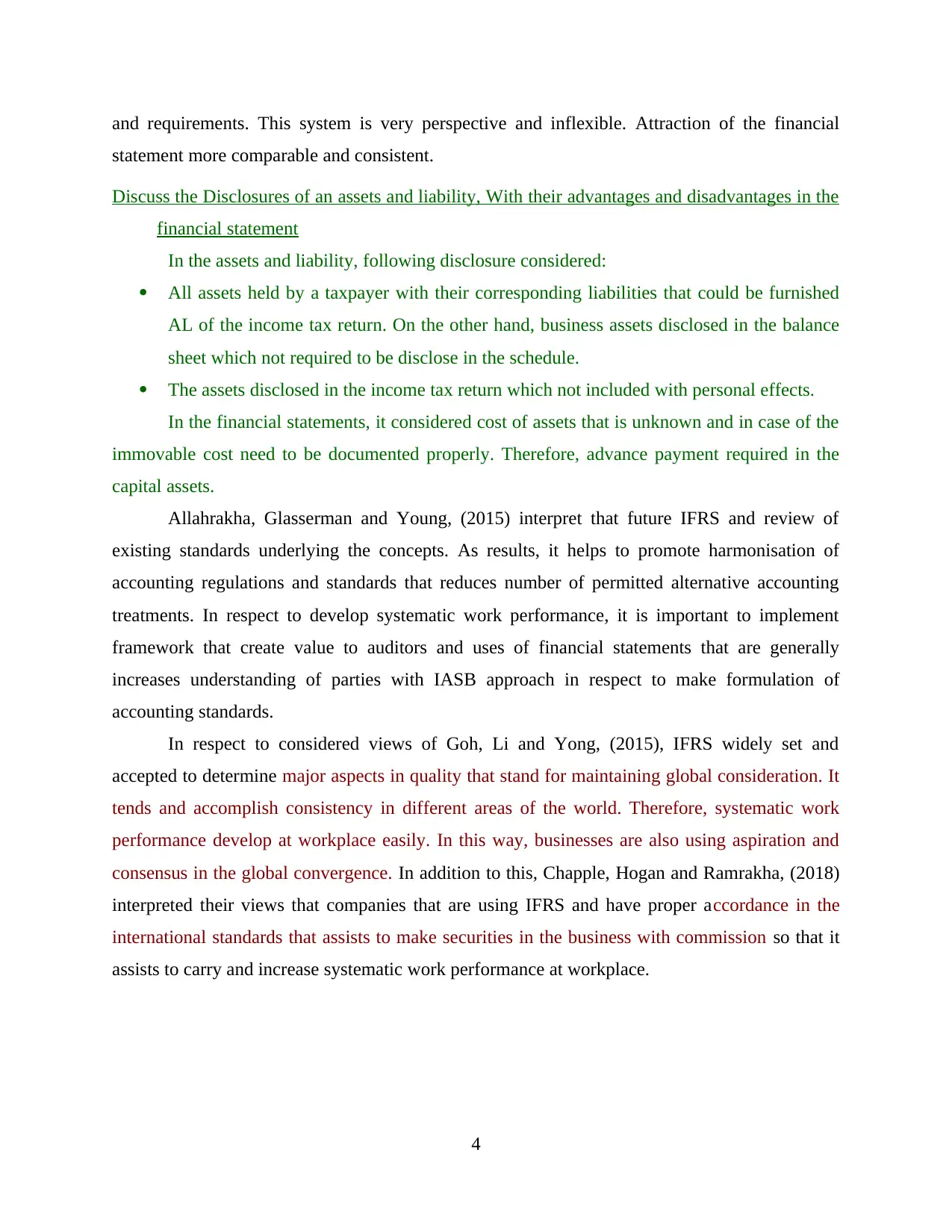
and requirements. This system is very perspective and inflexible. Attraction of the financial
statement more comparable and consistent.
Discuss the Disclosures of an assets and liability, With their advantages and disadvantages in the
financial statement
In the assets and liability, following disclosure considered:
All assets held by a taxpayer with their corresponding liabilities that could be furnished
AL of the income tax return. On the other hand, business assets disclosed in the balance
sheet which not required to be disclose in the schedule.
The assets disclosed in the income tax return which not included with personal effects.
In the financial statements, it considered cost of assets that is unknown and in case of the
immovable cost need to be documented properly. Therefore, advance payment required in the
capital assets.
Allahrakha, Glasserman and Young, (2015) interpret that future IFRS and review of
existing standards underlying the concepts. As results, it helps to promote harmonisation of
accounting regulations and standards that reduces number of permitted alternative accounting
treatments. In respect to develop systematic work performance, it is important to implement
framework that create value to auditors and uses of financial statements that are generally
increases understanding of parties with IASB approach in respect to make formulation of
accounting standards.
In respect to considered views of Goh, Li and Yong, (2015), IFRS widely set and
accepted to determine major aspects in quality that stand for maintaining global consideration. It
tends and accomplish consistency in different areas of the world. Therefore, systematic work
performance develop at workplace easily. In this way, businesses are also using aspiration and
consensus in the global convergence. In addition to this, Chapple, Hogan and Ramrakha, (2018)
interpreted their views that companies that are using IFRS and have proper accordance in the
international standards that assists to make securities in the business with commission so that it
assists to carry and increase systematic work performance at workplace.
4
statement more comparable and consistent.
Discuss the Disclosures of an assets and liability, With their advantages and disadvantages in the
financial statement
In the assets and liability, following disclosure considered:
All assets held by a taxpayer with their corresponding liabilities that could be furnished
AL of the income tax return. On the other hand, business assets disclosed in the balance
sheet which not required to be disclose in the schedule.
The assets disclosed in the income tax return which not included with personal effects.
In the financial statements, it considered cost of assets that is unknown and in case of the
immovable cost need to be documented properly. Therefore, advance payment required in the
capital assets.
Allahrakha, Glasserman and Young, (2015) interpret that future IFRS and review of
existing standards underlying the concepts. As results, it helps to promote harmonisation of
accounting regulations and standards that reduces number of permitted alternative accounting
treatments. In respect to develop systematic work performance, it is important to implement
framework that create value to auditors and uses of financial statements that are generally
increases understanding of parties with IASB approach in respect to make formulation of
accounting standards.
In respect to considered views of Goh, Li and Yong, (2015), IFRS widely set and
accepted to determine major aspects in quality that stand for maintaining global consideration. It
tends and accomplish consistency in different areas of the world. Therefore, systematic work
performance develop at workplace easily. In this way, businesses are also using aspiration and
consensus in the global convergence. In addition to this, Chapple, Hogan and Ramrakha, (2018)
interpreted their views that companies that are using IFRS and have proper accordance in the
international standards that assists to make securities in the business with commission so that it
assists to carry and increase systematic work performance at workplace.
4
⊘ This is a preview!⊘
Do you want full access?
Subscribe today to unlock all pages.

Trusted by 1+ million students worldwide
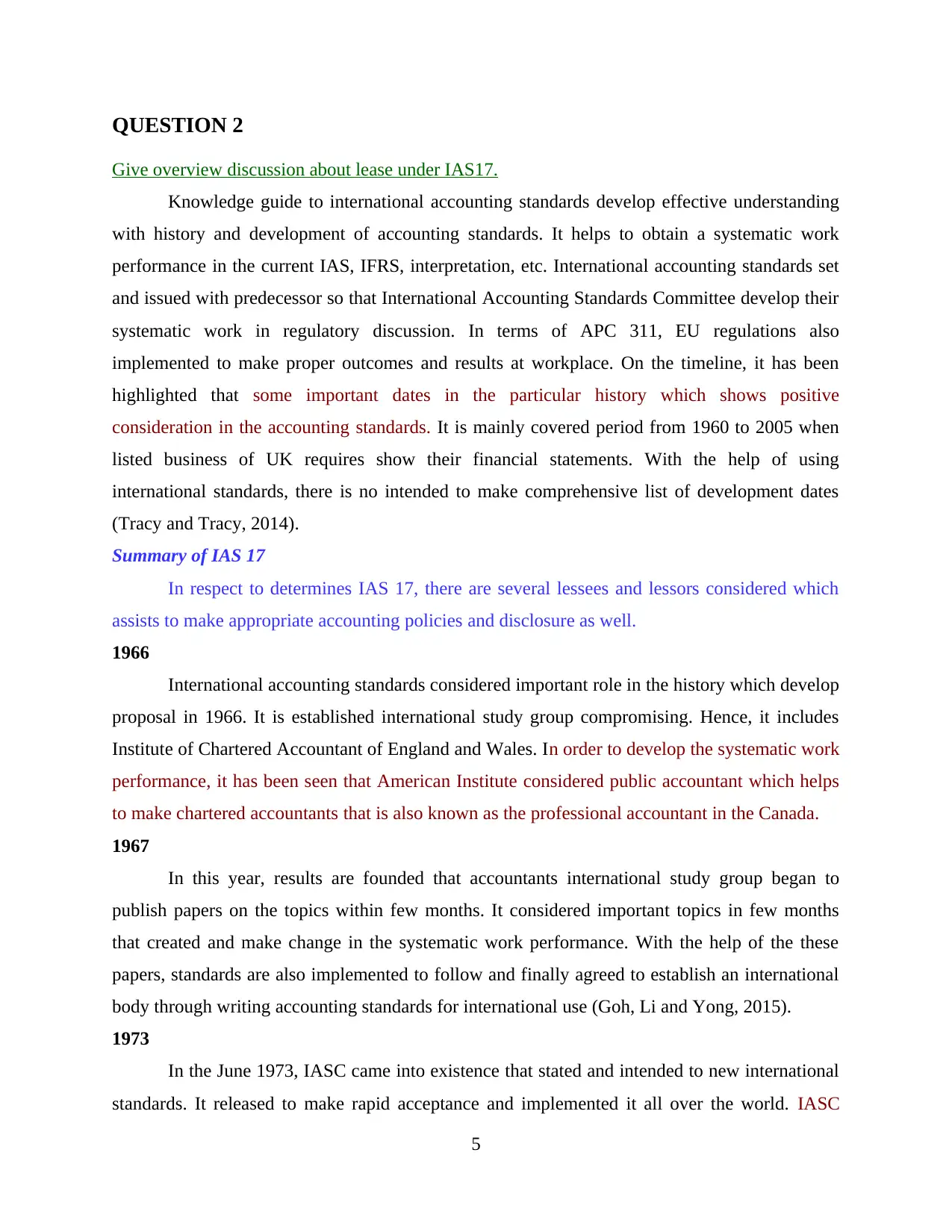
QUESTION 2
Give overview discussion about lease under IAS17.
Knowledge guide to international accounting standards develop effective understanding
with history and development of accounting standards. It helps to obtain a systematic work
performance in the current IAS, IFRS, interpretation, etc. International accounting standards set
and issued with predecessor so that International Accounting Standards Committee develop their
systematic work in regulatory discussion. In terms of APC 311, EU regulations also
implemented to make proper outcomes and results at workplace. On the timeline, it has been
highlighted that some important dates in the particular history which shows positive
consideration in the accounting standards. It is mainly covered period from 1960 to 2005 when
listed business of UK requires show their financial statements. With the help of using
international standards, there is no intended to make comprehensive list of development dates
(Tracy and Tracy, 2014).
Summary of IAS 17
In respect to determines IAS 17, there are several lessees and lessors considered which
assists to make appropriate accounting policies and disclosure as well.
1966
International accounting standards considered important role in the history which develop
proposal in 1966. It is established international study group compromising. Hence, it includes
Institute of Chartered Accountant of England and Wales. In order to develop the systematic work
performance, it has been seen that American Institute considered public accountant which helps
to make chartered accountants that is also known as the professional accountant in the Canada.
1967
In this year, results are founded that accountants international study group began to
publish papers on the topics within few months. It considered important topics in few months
that created and make change in the systematic work performance. With the help of the these
papers, standards are also implemented to follow and finally agreed to establish an international
body through writing accounting standards for international use (Goh, Li and Yong, 2015).
1973
In the June 1973, IASC came into existence that stated and intended to new international
standards. It released to make rapid acceptance and implemented it all over the world. IASC
5
Give overview discussion about lease under IAS17.
Knowledge guide to international accounting standards develop effective understanding
with history and development of accounting standards. It helps to obtain a systematic work
performance in the current IAS, IFRS, interpretation, etc. International accounting standards set
and issued with predecessor so that International Accounting Standards Committee develop their
systematic work in regulatory discussion. In terms of APC 311, EU regulations also
implemented to make proper outcomes and results at workplace. On the timeline, it has been
highlighted that some important dates in the particular history which shows positive
consideration in the accounting standards. It is mainly covered period from 1960 to 2005 when
listed business of UK requires show their financial statements. With the help of using
international standards, there is no intended to make comprehensive list of development dates
(Tracy and Tracy, 2014).
Summary of IAS 17
In respect to determines IAS 17, there are several lessees and lessors considered which
assists to make appropriate accounting policies and disclosure as well.
1966
International accounting standards considered important role in the history which develop
proposal in 1966. It is established international study group compromising. Hence, it includes
Institute of Chartered Accountant of England and Wales. In order to develop the systematic work
performance, it has been seen that American Institute considered public accountant which helps
to make chartered accountants that is also known as the professional accountant in the Canada.
1967
In this year, results are founded that accountants international study group began to
publish papers on the topics within few months. It considered important topics in few months
that created and make change in the systematic work performance. With the help of the these
papers, standards are also implemented to follow and finally agreed to establish an international
body through writing accounting standards for international use (Goh, Li and Yong, 2015).
1973
In the June 1973, IASC came into existence that stated and intended to new international
standards. It released to make rapid acceptance and implemented it all over the world. IASC
5
Paraphrase This Document
Need a fresh take? Get an instant paraphrase of this document with our AI Paraphraser
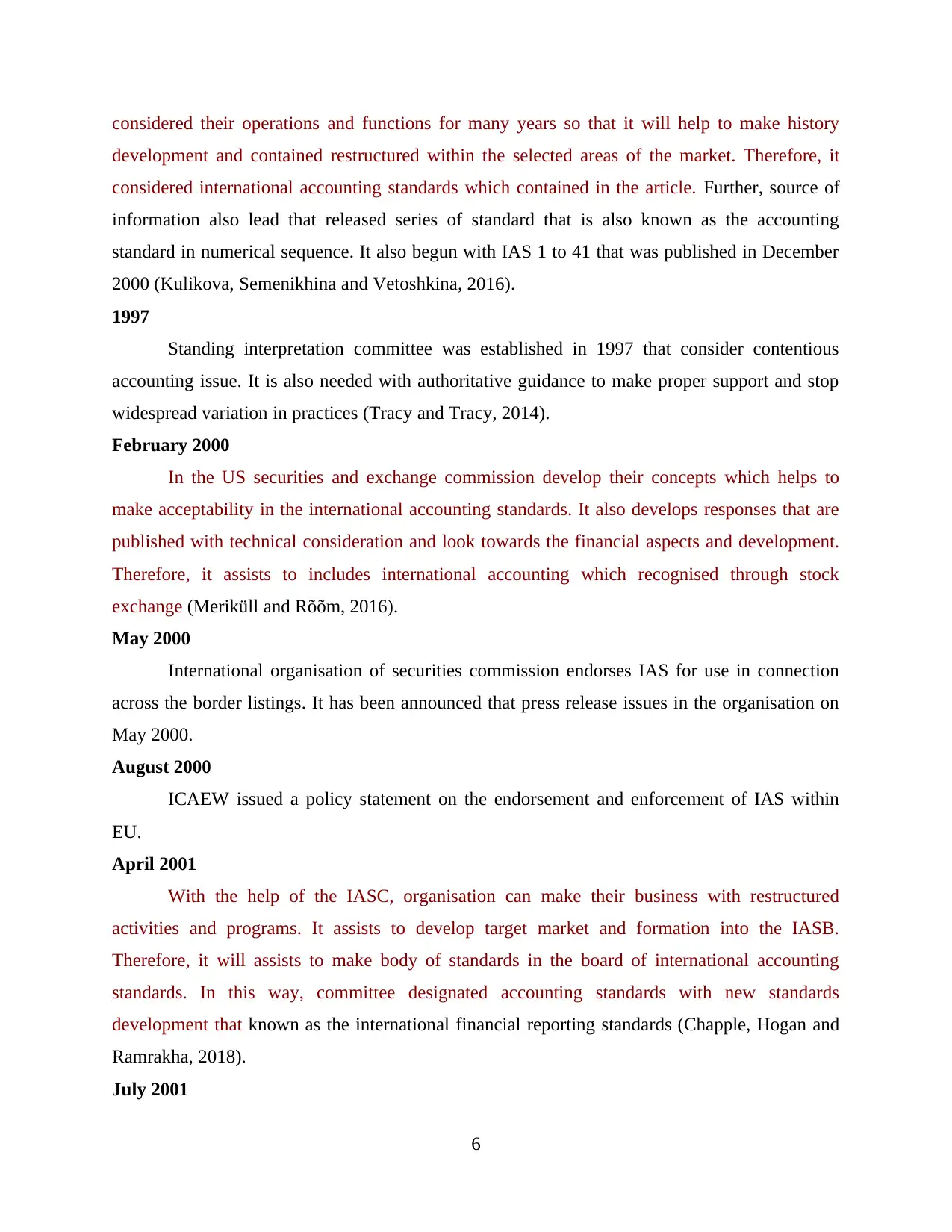
considered their operations and functions for many years so that it will help to make history
development and contained restructured within the selected areas of the market. Therefore, it
considered international accounting standards which contained in the article. Further, source of
information also lead that released series of standard that is also known as the accounting
standard in numerical sequence. It also begun with IAS 1 to 41 that was published in December
2000 (Kulikova, Semenikhina and Vetoshkina, 2016).
1997
Standing interpretation committee was established in 1997 that consider contentious
accounting issue. It is also needed with authoritative guidance to make proper support and stop
widespread variation in practices (Tracy and Tracy, 2014).
February 2000
In the US securities and exchange commission develop their concepts which helps to
make acceptability in the international accounting standards. It also develops responses that are
published with technical consideration and look towards the financial aspects and development.
Therefore, it assists to includes international accounting which recognised through stock
exchange (Meriküll and Rõõm, 2016).
May 2000
International organisation of securities commission endorses IAS for use in connection
across the border listings. It has been announced that press release issues in the organisation on
May 2000.
August 2000
ICAEW issued a policy statement on the endorsement and enforcement of IAS within
EU.
April 2001
With the help of the IASC, organisation can make their business with restructured
activities and programs. It assists to develop target market and formation into the IASB.
Therefore, it will assists to make body of standards in the board of international accounting
standards. In this way, committee designated accounting standards with new standards
development that known as the international financial reporting standards (Chapple, Hogan and
Ramrakha, 2018).
July 2001
6
development and contained restructured within the selected areas of the market. Therefore, it
considered international accounting standards which contained in the article. Further, source of
information also lead that released series of standard that is also known as the accounting
standard in numerical sequence. It also begun with IAS 1 to 41 that was published in December
2000 (Kulikova, Semenikhina and Vetoshkina, 2016).
1997
Standing interpretation committee was established in 1997 that consider contentious
accounting issue. It is also needed with authoritative guidance to make proper support and stop
widespread variation in practices (Tracy and Tracy, 2014).
February 2000
In the US securities and exchange commission develop their concepts which helps to
make acceptability in the international accounting standards. It also develops responses that are
published with technical consideration and look towards the financial aspects and development.
Therefore, it assists to includes international accounting which recognised through stock
exchange (Meriküll and Rõõm, 2016).
May 2000
International organisation of securities commission endorses IAS for use in connection
across the border listings. It has been announced that press release issues in the organisation on
May 2000.
August 2000
ICAEW issued a policy statement on the endorsement and enforcement of IAS within
EU.
April 2001
With the help of the IASC, organisation can make their business with restructured
activities and programs. It assists to develop target market and formation into the IASB.
Therefore, it will assists to make body of standards in the board of international accounting
standards. In this way, committee designated accounting standards with new standards
development that known as the international financial reporting standards (Chapple, Hogan and
Ramrakha, 2018).
July 2001
6
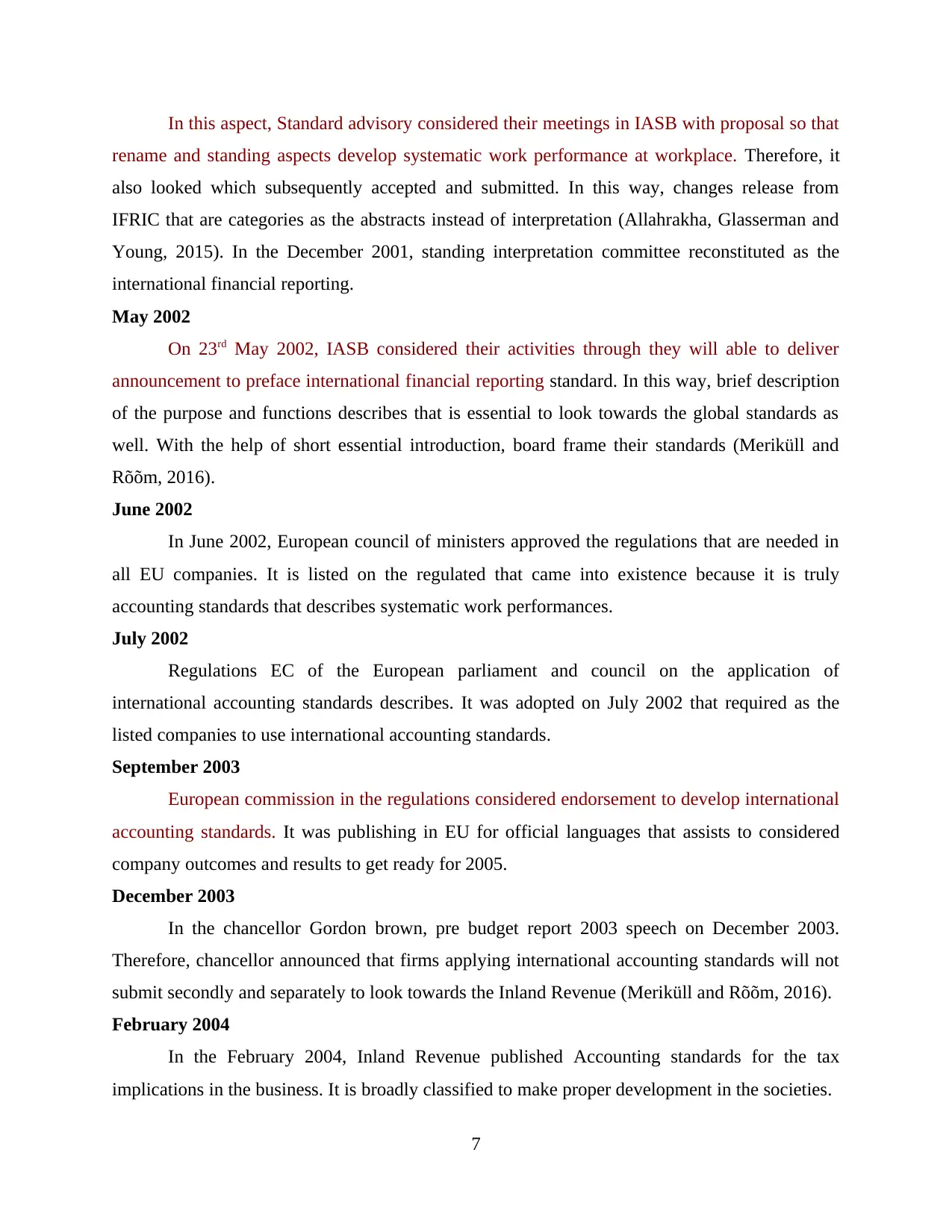
In this aspect, Standard advisory considered their meetings in IASB with proposal so that
rename and standing aspects develop systematic work performance at workplace. Therefore, it
also looked which subsequently accepted and submitted. In this way, changes release from
IFRIC that are categories as the abstracts instead of interpretation (Allahrakha, Glasserman and
Young, 2015). In the December 2001, standing interpretation committee reconstituted as the
international financial reporting.
May 2002
On 23rd May 2002, IASB considered their activities through they will able to deliver
announcement to preface international financial reporting standard. In this way, brief description
of the purpose and functions describes that is essential to look towards the global standards as
well. With the help of short essential introduction, board frame their standards (Meriküll and
Rõõm, 2016).
June 2002
In June 2002, European council of ministers approved the regulations that are needed in
all EU companies. It is listed on the regulated that came into existence because it is truly
accounting standards that describes systematic work performances.
July 2002
Regulations EC of the European parliament and council on the application of
international accounting standards describes. It was adopted on July 2002 that required as the
listed companies to use international accounting standards.
September 2003
European commission in the regulations considered endorsement to develop international
accounting standards. It was publishing in EU for official languages that assists to considered
company outcomes and results to get ready for 2005.
December 2003
In the chancellor Gordon brown, pre budget report 2003 speech on December 2003.
Therefore, chancellor announced that firms applying international accounting standards will not
submit secondly and separately to look towards the Inland Revenue (Meriküll and Rõõm, 2016).
February 2004
In the February 2004, Inland Revenue published Accounting standards for the tax
implications in the business. It is broadly classified to make proper development in the societies.
7
rename and standing aspects develop systematic work performance at workplace. Therefore, it
also looked which subsequently accepted and submitted. In this way, changes release from
IFRIC that are categories as the abstracts instead of interpretation (Allahrakha, Glasserman and
Young, 2015). In the December 2001, standing interpretation committee reconstituted as the
international financial reporting.
May 2002
On 23rd May 2002, IASB considered their activities through they will able to deliver
announcement to preface international financial reporting standard. In this way, brief description
of the purpose and functions describes that is essential to look towards the global standards as
well. With the help of short essential introduction, board frame their standards (Meriküll and
Rõõm, 2016).
June 2002
In June 2002, European council of ministers approved the regulations that are needed in
all EU companies. It is listed on the regulated that came into existence because it is truly
accounting standards that describes systematic work performances.
July 2002
Regulations EC of the European parliament and council on the application of
international accounting standards describes. It was adopted on July 2002 that required as the
listed companies to use international accounting standards.
September 2003
European commission in the regulations considered endorsement to develop international
accounting standards. It was publishing in EU for official languages that assists to considered
company outcomes and results to get ready for 2005.
December 2003
In the chancellor Gordon brown, pre budget report 2003 speech on December 2003.
Therefore, chancellor announced that firms applying international accounting standards will not
submit secondly and separately to look towards the Inland Revenue (Meriküll and Rõõm, 2016).
February 2004
In the February 2004, Inland Revenue published Accounting standards for the tax
implications in the business. It is broadly classified to make proper development in the societies.
7
⊘ This is a preview!⊘
Do you want full access?
Subscribe today to unlock all pages.

Trusted by 1+ million students worldwide
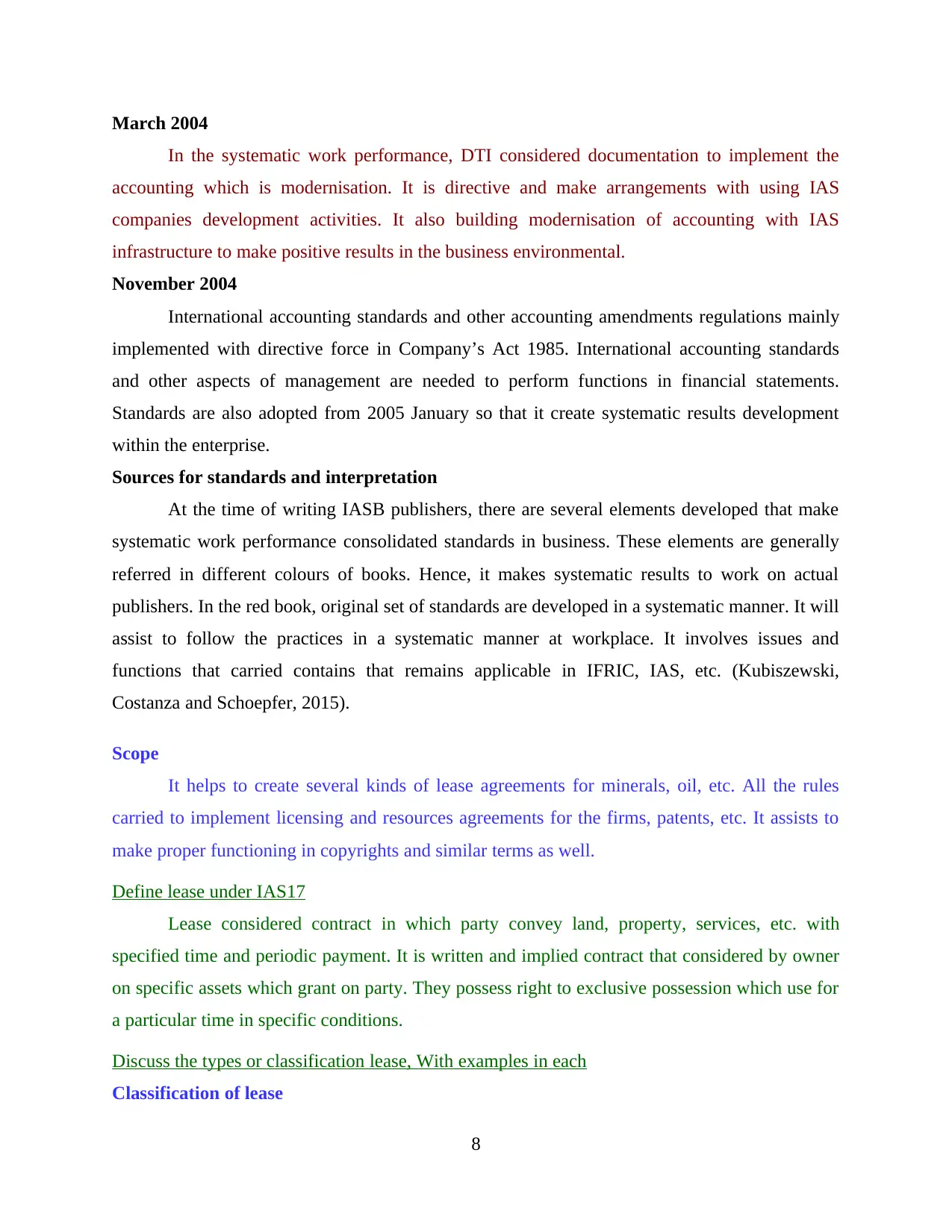
March 2004
In the systematic work performance, DTI considered documentation to implement the
accounting which is modernisation. It is directive and make arrangements with using IAS
companies development activities. It also building modernisation of accounting with IAS
infrastructure to make positive results in the business environmental.
November 2004
International accounting standards and other accounting amendments regulations mainly
implemented with directive force in Company’s Act 1985. International accounting standards
and other aspects of management are needed to perform functions in financial statements.
Standards are also adopted from 2005 January so that it create systematic results development
within the enterprise.
Sources for standards and interpretation
At the time of writing IASB publishers, there are several elements developed that make
systematic work performance consolidated standards in business. These elements are generally
referred in different colours of books. Hence, it makes systematic results to work on actual
publishers. In the red book, original set of standards are developed in a systematic manner. It will
assist to follow the practices in a systematic manner at workplace. It involves issues and
functions that carried contains that remains applicable in IFRIC, IAS, etc. (Kubiszewski,
Costanza and Schoepfer, 2015).
Scope
It helps to create several kinds of lease agreements for minerals, oil, etc. All the rules
carried to implement licensing and resources agreements for the firms, patents, etc. It assists to
make proper functioning in copyrights and similar terms as well.
Define lease under IAS17
Lease considered contract in which party convey land, property, services, etc. with
specified time and periodic payment. It is written and implied contract that considered by owner
on specific assets which grant on party. They possess right to exclusive possession which use for
a particular time in specific conditions.
Discuss the types or classification lease, With examples in each
Classification of lease
8
In the systematic work performance, DTI considered documentation to implement the
accounting which is modernisation. It is directive and make arrangements with using IAS
companies development activities. It also building modernisation of accounting with IAS
infrastructure to make positive results in the business environmental.
November 2004
International accounting standards and other accounting amendments regulations mainly
implemented with directive force in Company’s Act 1985. International accounting standards
and other aspects of management are needed to perform functions in financial statements.
Standards are also adopted from 2005 January so that it create systematic results development
within the enterprise.
Sources for standards and interpretation
At the time of writing IASB publishers, there are several elements developed that make
systematic work performance consolidated standards in business. These elements are generally
referred in different colours of books. Hence, it makes systematic results to work on actual
publishers. In the red book, original set of standards are developed in a systematic manner. It will
assist to follow the practices in a systematic manner at workplace. It involves issues and
functions that carried contains that remains applicable in IFRIC, IAS, etc. (Kubiszewski,
Costanza and Schoepfer, 2015).
Scope
It helps to create several kinds of lease agreements for minerals, oil, etc. All the rules
carried to implement licensing and resources agreements for the firms, patents, etc. It assists to
make proper functioning in copyrights and similar terms as well.
Define lease under IAS17
Lease considered contract in which party convey land, property, services, etc. with
specified time and periodic payment. It is written and implied contract that considered by owner
on specific assets which grant on party. They possess right to exclusive possession which use for
a particular time in specific conditions.
Discuss the types or classification lease, With examples in each
Classification of lease
8
Paraphrase This Document
Need a fresh take? Get an instant paraphrase of this document with our AI Paraphraser
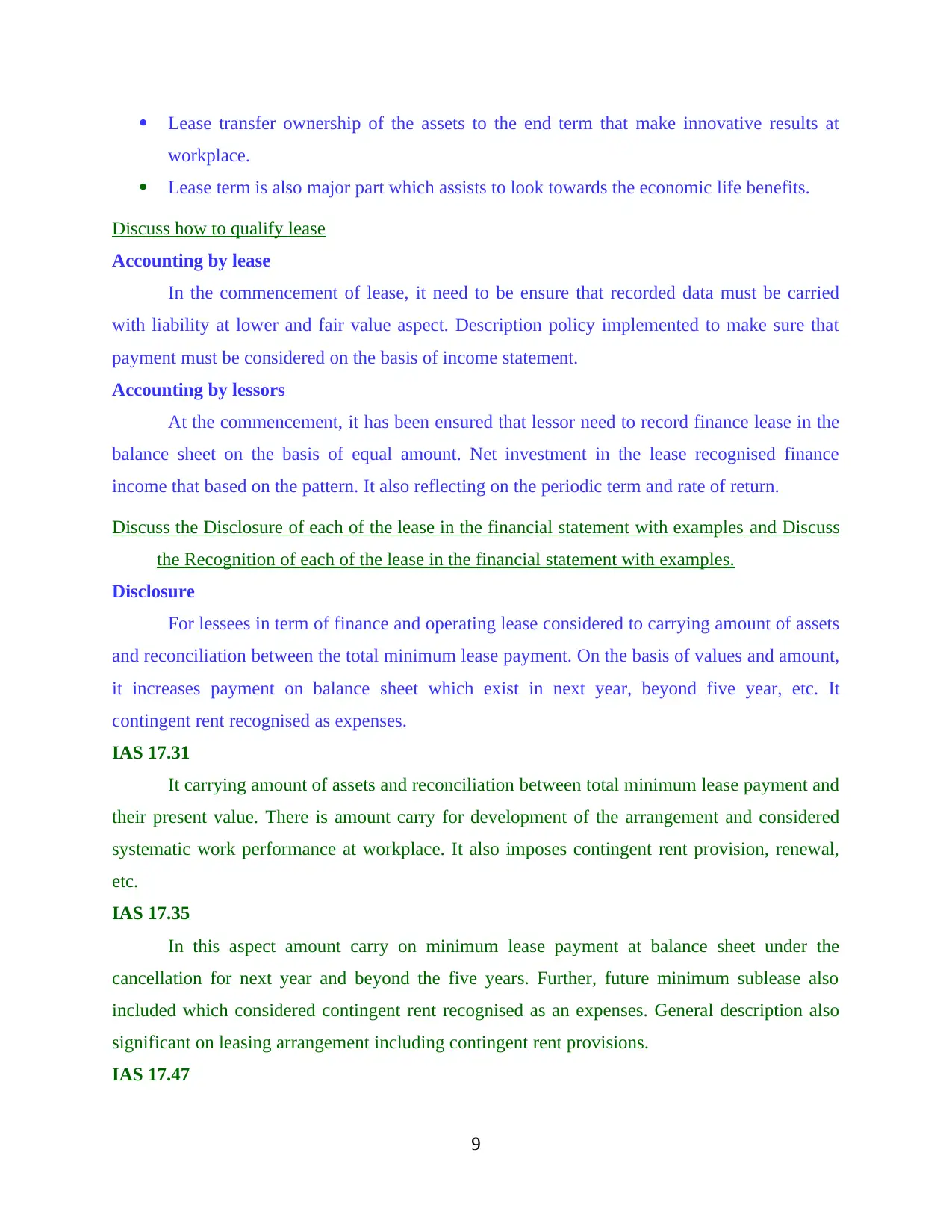
Lease transfer ownership of the assets to the end term that make innovative results at
workplace.
Lease term is also major part which assists to look towards the economic life benefits.
Discuss how to qualify lease
Accounting by lease
In the commencement of lease, it need to be ensure that recorded data must be carried
with liability at lower and fair value aspect. Description policy implemented to make sure that
payment must be considered on the basis of income statement.
Accounting by lessors
At the commencement, it has been ensured that lessor need to record finance lease in the
balance sheet on the basis of equal amount. Net investment in the lease recognised finance
income that based on the pattern. It also reflecting on the periodic term and rate of return.
Discuss the Disclosure of each of the lease in the financial statement with examples and Discuss
the Recognition of each of the lease in the financial statement with examples.
Disclosure
For lessees in term of finance and operating lease considered to carrying amount of assets
and reconciliation between the total minimum lease payment. On the basis of values and amount,
it increases payment on balance sheet which exist in next year, beyond five year, etc. It
contingent rent recognised as expenses.
IAS 17.31
It carrying amount of assets and reconciliation between total minimum lease payment and
their present value. There is amount carry for development of the arrangement and considered
systematic work performance at workplace. It also imposes contingent rent provision, renewal,
etc.
IAS 17.35
In this aspect amount carry on minimum lease payment at balance sheet under the
cancellation for next year and beyond the five years. Further, future minimum sublease also
included which considered contingent rent recognised as an expenses. General description also
significant on leasing arrangement including contingent rent provisions.
IAS 17.47
9
workplace.
Lease term is also major part which assists to look towards the economic life benefits.
Discuss how to qualify lease
Accounting by lease
In the commencement of lease, it need to be ensure that recorded data must be carried
with liability at lower and fair value aspect. Description policy implemented to make sure that
payment must be considered on the basis of income statement.
Accounting by lessors
At the commencement, it has been ensured that lessor need to record finance lease in the
balance sheet on the basis of equal amount. Net investment in the lease recognised finance
income that based on the pattern. It also reflecting on the periodic term and rate of return.
Discuss the Disclosure of each of the lease in the financial statement with examples and Discuss
the Recognition of each of the lease in the financial statement with examples.
Disclosure
For lessees in term of finance and operating lease considered to carrying amount of assets
and reconciliation between the total minimum lease payment. On the basis of values and amount,
it increases payment on balance sheet which exist in next year, beyond five year, etc. It
contingent rent recognised as expenses.
IAS 17.31
It carrying amount of assets and reconciliation between total minimum lease payment and
their present value. There is amount carry for development of the arrangement and considered
systematic work performance at workplace. It also imposes contingent rent provision, renewal,
etc.
IAS 17.35
In this aspect amount carry on minimum lease payment at balance sheet under the
cancellation for next year and beyond the five years. Further, future minimum sublease also
included which considered contingent rent recognised as an expenses. General description also
significant on leasing arrangement including contingent rent provisions.
IAS 17.47
9
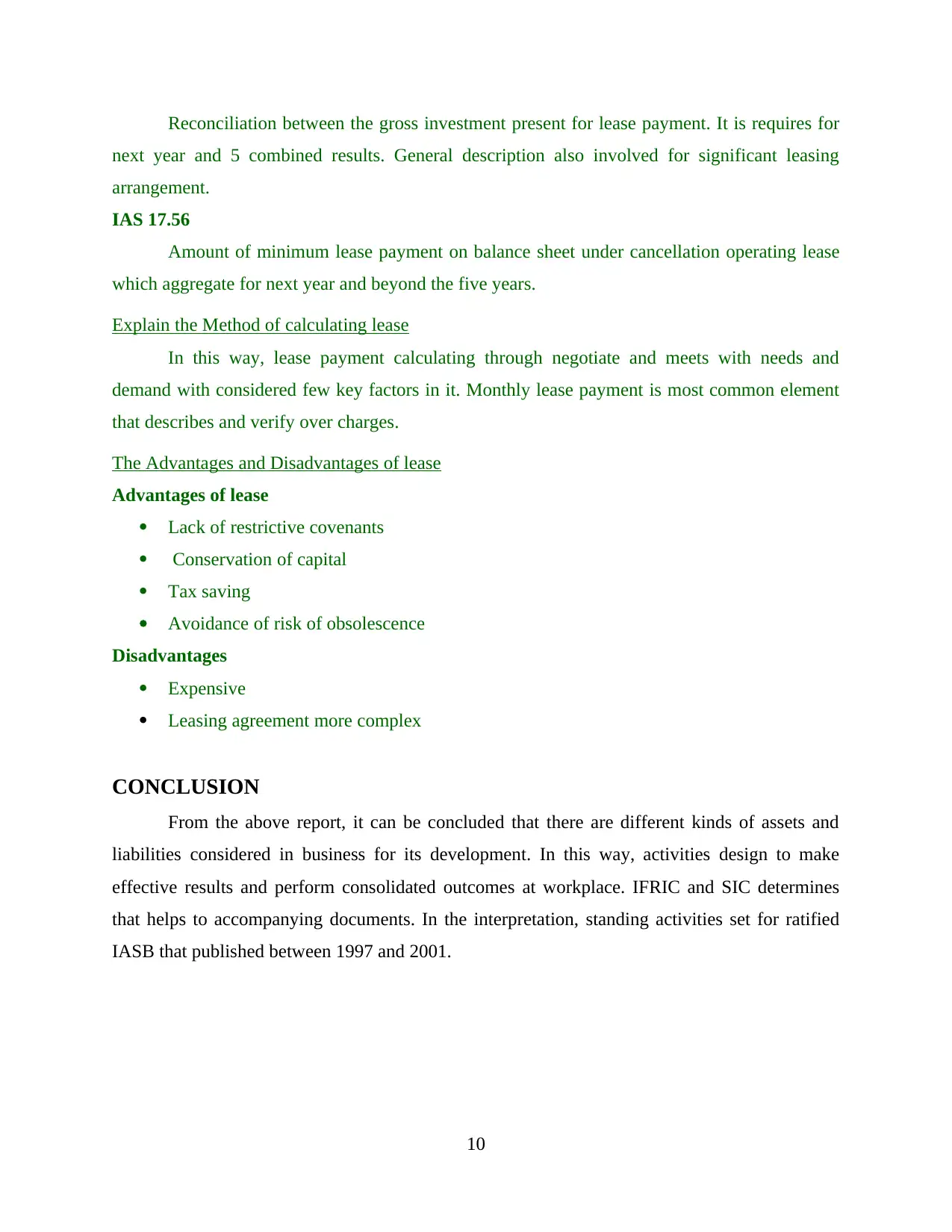
Reconciliation between the gross investment present for lease payment. It is requires for
next year and 5 combined results. General description also involved for significant leasing
arrangement.
IAS 17.56
Amount of minimum lease payment on balance sheet under cancellation operating lease
which aggregate for next year and beyond the five years.
Explain the Method of calculating lease
In this way, lease payment calculating through negotiate and meets with needs and
demand with considered few key factors in it. Monthly lease payment is most common element
that describes and verify over charges.
The Advantages and Disadvantages of lease
Advantages of lease
Lack of restrictive covenants
Conservation of capital
Tax saving
Avoidance of risk of obsolescence
Disadvantages
Expensive
Leasing agreement more complex
CONCLUSION
From the above report, it can be concluded that there are different kinds of assets and
liabilities considered in business for its development. In this way, activities design to make
effective results and perform consolidated outcomes at workplace. IFRIC and SIC determines
that helps to accompanying documents. In the interpretation, standing activities set for ratified
IASB that published between 1997 and 2001.
10
next year and 5 combined results. General description also involved for significant leasing
arrangement.
IAS 17.56
Amount of minimum lease payment on balance sheet under cancellation operating lease
which aggregate for next year and beyond the five years.
Explain the Method of calculating lease
In this way, lease payment calculating through negotiate and meets with needs and
demand with considered few key factors in it. Monthly lease payment is most common element
that describes and verify over charges.
The Advantages and Disadvantages of lease
Advantages of lease
Lack of restrictive covenants
Conservation of capital
Tax saving
Avoidance of risk of obsolescence
Disadvantages
Expensive
Leasing agreement more complex
CONCLUSION
From the above report, it can be concluded that there are different kinds of assets and
liabilities considered in business for its development. In this way, activities design to make
effective results and perform consolidated outcomes at workplace. IFRIC and SIC determines
that helps to accompanying documents. In the interpretation, standing activities set for ratified
IASB that published between 1997 and 2001.
10
⊘ This is a preview!⊘
Do you want full access?
Subscribe today to unlock all pages.

Trusted by 1+ million students worldwide
1 out of 13
Related Documents
Your All-in-One AI-Powered Toolkit for Academic Success.
+13062052269
info@desklib.com
Available 24*7 on WhatsApp / Email
![[object Object]](/_next/static/media/star-bottom.7253800d.svg)
Unlock your academic potential
Copyright © 2020–2025 A2Z Services. All Rights Reserved. Developed and managed by ZUCOL.





